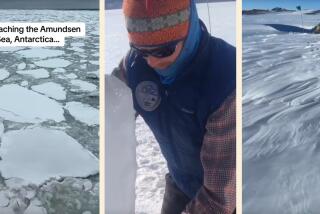Ransom A. Myers, 54; warned that overfishing posed sweeping threat
- Share via
Ransom A. Myers, a former government scientist who tried in vain to warn that overfishing would lead to the collapse of Atlantic cod populations and later discovered that 90% of the world’s bluefin tuna and other large predatory fish have disappeared, has died. He was 54.
Myers died Tuesday in Halifax, Nova Scotia, of complications of brain cancer, according to colleagues at Dalhousie University, where Myers was a professor of ocean studies. He was diagnosed with an inoperable brain tumor in November and spent his final months in the hospital able to speak only a few words.
Myers, who went by the nickname RAM, was a gifted mathematician and biologist who shook up the insular world of fisheries science with blunt statements about how various species of sharks, turtles and fish were headed toward extinction if industrial fishing didn’t retreat from excessive hunting.
“Humans have always been very good at killing big animals,” Myers said. “Ten thousand years ago, with just some pointed sticks, humans managed to wipe out the woolly mammoth, saber-toothed tigers, mastodons and giant vampire bats. The same could happen in the oceans.”
Such bold pronouncements didn’t spring from preconceived ideology, but rather from patterns he discerned from fishing records, scientific surveys and other data he collected from all over the world.
Myers had a unique ability to look at complex global changes and pick out trends that others had missed, said Boris Worm, a colleague at Dalhousie in Halifax. “Unlike most scientists who look at a snippet of reality, he believed we are facing global problems that need to be analyzed on a global scale and communicated on a global scale,” Worm said.
With the help of Worm, Myers spent years poring over five decades of Japanese log books and other fishing records to determine that 90% of the world’s sharks, tuna, swordfish, cod and other big predatory fish had been serially stripped from the seas by industrialized fishing since the early 1950s.
The result, published in 2003 in the scientific journal Nature, was front-page news around the world. It stirred scientific debate that continues, even though a review panel of the National Academy of Sciences has upheld its conclusions.
“We confirmed that the pattern was right,” said Andy Rosenberg, a panel member and longtime colleague now at the University of New Hampshire. “Most people criticizing the methodology didn’t like the answer.”
Myers’ plain-spoken style got him into trouble in the 1990s, when he began to condemn the Canadian government’s handling of the Atlantic cod fishery even though he worked for Canada’s Department of Fisheries and Oceans.
The department tried to squelch his papers, explaining that excessive harvesting was responsible for the 1992 collapse of Atlantic cod. The government had blamed everything from voracious seals to changes in water temperature for the decline. Later proven right, Myers recounted the censorship and other obfuscations that went on within the Canadian government that forced him to flee for the academic freedom at Dalhousie.
“He was even officially reprimanded for documenting what eventually became universally accepted as a particularly egregious case of overfishing combined with bad science,” said Daniel Pauly, director of the Fisheries Centre at the University of British Columbia in Vancouver. Myers brought out an uncomfortable truth to government officials, who were under pressure to keep fisheries open, colleagues said.
Myers believed strongly that any information collected at taxpayers’ expense should be made publicly available. He posted his data on websites and invited interested parties to try to pick apart his analysis, believing this was science’s pathway to the truth.
In October 2005, Fortune magazine declared him one of the top 10 people in the world to watch, listing him between U.S. Sen. Barack Obama (D-Ill.) and the co-founders of Google.
An enthusiastic problem solver, Myers brought a childlike glee to the collection and analysis of fishing records, scientific surveys, newspaper records or any other type of data he could get into his hands -- or more accurately his computer.
The bearded, bespectacled biologist showed up at scientific meetings around the globe wearing trademark shorts, sandals with socks and a mischievous grin. He was there, he said, “to mine data,” typing on his laptop computer in a frenzy of multi-tasking. Myers’ brain operated in a whirl, spinning so fast his words sometimes had difficulty keeping up.
Born and raised in the tiny town of Lula, Miss., Ransom Aldrich Myers Jr. was one of four children and the namesake son of a cotton farmer who owned a plantation stretching across thousands of acres.
In grade school, his teachers were worried that he was slow to learn to read, according to his younger sister, Susan G. Myers. But by high school, his teachers said that he shouldn’t bother coming to school. It was for another reason: There was apparently nothing they could teach him that he hadn’t already mastered.
At age 16, he won an international science fair with an “X-ray crystallograph” that measured the symmetry between atoms -- a delicate instrument that he built in his bedroom. The Massachusetts Institute of Technology tried to recruit Myers for its physics department, but his father wouldn’t stand for it. “My father wouldn’t let him go because it was north of the Mason-Dixon line,” Myers’ sister said, explaining that deep Southern roots included ancestors who were Confederate soldiers.
So Myers earned a physics degree at Rice University in Houston and then worked in the oilfields of Kuwait as a physicist to earn some money before departing on a series of adventures that took him trekking in Nepal, backpacking through Africa and sailing across the Atlantic from Africa to the Caribbean in a 28-foot boat.
It was during this time that he became interested in fish, his sister said. Not wanting to displease his father, he ventured farther north than the Yankee north and enrolled in Dalhousie University, where he received a master’s degree in mathematics and a PhD in biology.
Myers published prolifically in scientific journals to the very end, including a paper on sharks that will appear in Friday’s edition of the journal Science.
In recent years, he wrote a number of papers on how once-common sharks were rapidly disappearing in part because fishermen catch them to harvest their fins for Chinese soup.
“My son loves hammerheads,” Myers said a few years ago of his son, now age 9. “I’d like to make sure they are around when he grows up.”
Myers is survived by his wife, Rita; his five children, Emily, Rosemary, Sophia, Carlo and Gioia; and his siblings, Abbott Ransom Myers, Joan Peters and Susan Myers.






